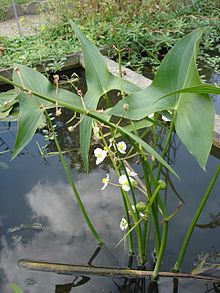Sagittaria latifolia

Sagittaria latifolia is a plant found in shallow wetlands and is sometimes known as broadleaf arrowhead,[2] duck-potato,[3] Indian potato, or wapato. This plant produces edible tubers that have traditionally been extensively used by the indigenous peoples of the Americas.[1]
Sagittaria latifolia is a variably sized (2 to 20 metres (6.6 to 65.6 ft) in length) perennial growing in colonies that can cover large amounts of ground. The roots are white and thin, producing white tubers covered with a purplish skin a good distance (0.3 to 1 metre (12 to 39 in) long, 0.15 to 0.6 metres (5.9 to 23.6 in) deep) from the mother plant. It is green and white. The plant produces rosette of leaves and an inflorescence on a long rigid scape. The leaves are extremely variable, from very thin at 1 to 2 cm to wedge shaped like those of Sagittaria cuneata. Spongy and solid, the leaves have parallel venation meeting in the middle and the extremities. The inflorescence is a raceme composed of large flowers whorled by threes. Usually divided into female flowers on the lower part and male on the upper, although dioecious individuals are also found. Three round, white petals and three very short curved, dark green sepals. Male flowers are easily distinguished from female due to the dissimilarity between the 25 to 50 yellow stamens of the male and the sphere of green carpels of the female ones.[4][5][6][7][8][9][10][11]
The name of Shubenacadie, a community located in central Nova Scotia, Canada, means “abounding in ground nuts” (i.e., broadleaf arrowhead) in the Mi’kmaq language.
